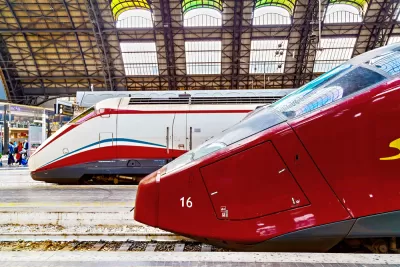European countries are committing to making intercity rail the preferable option compared to domestic and intra-continental flights. The shift seems to be working in Italy.

Over two thirds of people traveling between Roma and Milan take the train, with the number of passengers on the route (the main business route in Italy) quadrupling over the past decade. The trend in Italy reflects a broader cultural movement in Europe and achieves the desired effect of specific policy efforts of countries like Germany and France.
An article by Julia Buckley speculates about whether the success of intercity rail in Italy contributed to the demise of Alitalia—the national airline is shutting down business today.
According to the article, Alitalia tended to focus on domestic flights, so it "was a bird with its wings very much clipped from the start." The article mostly credits the demise of the airline on the market, not public policy. According to sources cited in the article, a "cocktail" of low-cost airlines and high-speed trains proved too much competition for the airline. On the rail side, there are now two high-speed rail companies (one public, Trenitalia, and one private, Nuovo Trasporto Viaggiatori) to choose from, and the rail infrastructure of the country is dramatically improved from the country's past.
According to Buckley's sources, tourists and Italians alike find the trains easier, cheaper, and quicker than flying. The consequences of this shift have spread to other sectors of the economy as well. "While real estate prices in Milan dipped 20.5% from 2008 to 2018, prices for offices around the high-speed stations of Rogoredo and Porta Garibaldi were up around 10%," according to Buckley.
FULL STORY: How Italy's high-speed trains helped kill Alitalia

Study: Maui’s Plan to Convert Vacation Rentals to Long-Term Housing Could Cause Nearly $1 Billion Economic Loss
The plan would reduce visitor accommodation by 25,% resulting in 1,900 jobs lost.

North Texas Transit Leaders Tout Benefits of TOD for Growing Region
At a summit focused on transit-oriented development, policymakers discussed how North Texas’ expanded light rail system can serve as a tool for economic growth.

Using Old Oil and Gas Wells for Green Energy Storage
Penn State researchers have found that repurposing abandoned oil and gas wells for geothermal-assisted compressed-air energy storage can boost efficiency, reduce environmental risks, and support clean energy and job transitions.

Santa Barbara Could Build Housing on County Land
County supervisors moved forward a proposal to build workforce housing on two county-owned parcels.

San Mateo Formally Opposes Freeway Project
The city council will send a letter to Caltrans urging the agency to reconsider a plan to expand the 101 through the city of San Mateo.

A Bronx Community Fights to Have its Voice Heard
After organizing and giving input for decades, the community around the Kingsbridge Armory might actually see it redeveloped — and they want to continue to have a say in how it goes.
Urban Design for Planners 1: Software Tools
This six-course series explores essential urban design concepts using open source software and equips planners with the tools they need to participate fully in the urban design process.
Planning for Universal Design
Learn the tools for implementing Universal Design in planning regulations.
Ascent Environmental
Borough of Carlisle
Institute for Housing and Urban Development Studies (IHS)
City of Grandview
Harvard GSD Executive Education
Toledo-Lucas County Plan Commissions
Salt Lake City
NYU Wagner Graduate School of Public Service





























